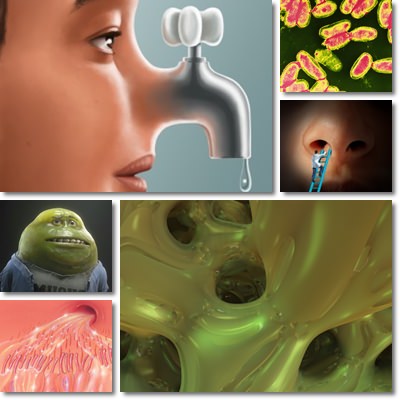Many of us have often had to deal with the bother of expectorating phlegm after a more serious respiratory infection and, although we might have thought the worst was gone, it turned out getting rid of phlegm proved more difficult and lengthy than expected. Following a nasty flu virus last November and a rather slow recovery, I too was faced with problems expectorating the leftover phlegm. It took a while since I found myself coughing it up even one month later. Despite this, I eventually succeeded and overcame the flu episode completely.
What is phlegm?
Phlegm is a thick secretion produced by the mucous membranes of our respiratory system. It is the part of mucus we expel through the mouth via coughing. The reason why phlegm has a different consistency than normal mucus is due to changes in its composition (inflammatory agents, bacteria, viruses) as a result of disease. When we have a cold, catch the flu, develop bronchitis or other respiratory problem, the mucous membranes covering our airways produce more mucus than usual. Mucus combines with dead bacteria our body has fought off and tries to eliminate and both are expectorated in the form of phlegm.

The appearance of phlegm has to do with the nature and severity of the respiratory infection causing it. The more severe the infection, the greater the inflammation and the more consistent or thick the phlegm. Similarly, the nature of the respiratory infection (viral, bacterial) and its evolutionary stage influences phlegm color. Of course, not all phlegm is caused by an infections and more benign causes such as allergies or allergic rhinitis (aka hay fever) are possible. Overall, there are two types of mucous secretions:
Types of phlegm
Liquid secretions
Mucous secretions that have a more liquid consistency are often the result of cold, flu or allergies such as pollen allergy. In the case of allergies, secretions should be slightly translucent or whitish, indicating usually just inflammation, not the presence of viruses or bacteria.
Dense, gel-like secretions
Thicker secretions are the result of more severe respiratory tract infections such as bronchitis. Food allergies, excessive dairy consumption, acid reflux are factors that worsen the condition. And the continuous oozing of thick mucous secretions in the back of the throat may create the sensation of having phlegm in the stomach.

What does phlegm color mean?
Here are the main types of phlegm color and what they mean:
White or gray phlegm
A thick, clear-white or grayish phlegm may indicate an infection of the upper respiratory tract or sinus congestion. Other causes for dense, white mucus secretions are asthma, acid reflux, seasonal allergies or chronic bronchitis. White phlegm accompanied by symptoms such as fever, nasal congestion or pressure above the nose area usually indicates an infection such as ear infection, sinus infection etc. Runny, whitish phlegm may indicate seasonal allergies and gray specks could be caused by dust or dirt having entered the nose or mouth.
Yellow phlegm
Thick, dark yellow or dirty yellow phlegm is most often a strong indicator of a bacterial infection, in which case you should see your doctor for appropriate treatment. Generally, yellow phlegm appears about 3 days after the debut of an infection and indicates the immune system is working on killing off the pathogens responsible for the attack. Yellow phlegm is not a result of infectious pathogens alone; white blood cells fighting off the infection (antibodies), cellular debris, proteins all contribute to the thick consistency and color of phlegm.
Green phlegm
Green phlegm is often a result of a long-term infection or, in some cases, of a non-infectious inflammatory cause. It may be accompanied by a bad odour and can require a sputum examination prior to being prescribed any treatment option by a healthcare professional. Sputum is the name given to phlegm once it is expectorated by mouth. Green phlegm often indicates a more serious infection than yellow phlegm.
Brown phlegm
Brown phlegm is frequently associated with smoking. It often has a grainy structure due to dust and foreign materials inhaled in the lungs. Smoking damages the lungs in time, making it harder for them to expel foreign materials, hence their presence in phlegm.
Pink or rose phlegm
Streaks of pink or rose in an otherwise clear phlegm indicates the presence of blood as a result of nasal tissue breaking as a result of irritated, dry skin from blowing the nose too hard. When there are more than a few, almost invisible streaks of blood, then you should go see a doctor immediately, especially if you manifest symptoms such as fatigue, weakness, irregular heart beat, persistent cough as well.
Also see what nose mucus colors mean.
How to get rid of phlegm?
In case of a bacterial infection, often indicated by thick, yellow phlegm along with other telling symptoms (fever, coughing, etc.), the only sensible thing to do is go to your doctor so he or she can prescribe you antibiotics. Phlegm expectoration may continue long after ending the antibiotic treatment and can become quite frustrating and worrisome, unless you know how to get rid of it. Find out below what are my top 5 remedies to get rid of phlegm:
Steam
Go to the bathroom, turn on the hot water in your shower and let steam build up for 5-8 minutes. This should help loosen the phlegm in your lungs as well as inactivate dust or other allergens for those of you with allergies and asthma. For some people, a hot shower is enough, but others may require a bit of sauna in the bathroom. Another good alternative is to bring a pot of water to the boiling point, cover your head with a towel and lean over it to inhale the steam. You can also add calming herbs such as sage or thyme to the pot.
Hot chicken soup
Sometimes, traditional remedies work better than conventional ones. According to the National Center for Biotechnology Information, a simple bowl of hot chicken soup can help reduce inflammation and prevent the migration of a type of white blood cells, hence the soothing effects of the soup (Chicken soup inhibits neutrophil chemotaxis in vitro, 2000). In addition to being a mild natural anti-inflammatory, chicken soup also improves nutrition and hydration, the latter also contributing to the loosening of phlegm in view of an easier expectoration.
Herbal teas
A cup of hot herbal tea can do wonders for anyone fighting off a cold, flu or other respiratory problem, provided the right herbs are used. Infuse ginger and mint to help relieve nasal congestion and, more importantly, reduce inflammation. By reducing inflammation (thanks to ginger), you get less activity from mucus-producing tissues, resulting in less phlegm, which is also more liquid and easier to expectorate. Sweeten your tea with acacia honey (least allergenic) with propolis for incredible antimicrobial benefits. You can also add a few drops of lemon juice to add to the benefits.
Vapor rub
Rub some vapor rub on your upper chest to help relieve nasal congestion and promote expectoration. It can be either a good brand of vapor rub or a home made version using only natural ingredients. The best choices are clove oil, rosemary oil, eucalyptus oil, peppermint or thyme oil. You can use it as such or combine it with olive or coconut oil and natural beeswax to help better bind the ingredients together.
Garlic and turmeric
If your stomach can take it, eat or swallow whole one garlic clove every day to boost your immunity. The allicin in garlic acts as a natural antibiotic increasing the body’s ability to fight off the infection. You can also include turmeric in your daily diet. Turmeric is an amazing natural anti-inflammatory which should greatly help relieve the inflammation by generating an increase in mucus production. Golden milk, a turmeric milk preparation, could also help get rid of phlegm; at the same time, if you use dairy milk, it could have the opposite effect. F
ind out what golden milk is and how to make it with both dairy and non-dairy milk in my article on the benefits of golden milk.
What to avoid for excess phlegm
Nevertheless, just as some foods are great at facilitating recovery, others may greatly impede it and further contribute to difficulty in eliminating phlegm. Here are 4 things you need to avoid when trying to reduce phlegm production:
- Cold food and cold surroundings. Anything cold distresses the body further, increasing inflammation levels and, consequently, mucus production.
- Hot and dry food and surroundings. Just as cold is bad for you, so is anything hot and dry, with emphasis on hot. Make sure you don’t eat dry foods that might irritate or bruise your already sensitive tissues. Similarly, make certain there is enough humidity in your home to help you better expectorate phlegm.
- Fried foods, eggs and dairy. All of these foods tend to increase mucus production and density, contributing to more persistent phlegm that is difficult to eliminate.
- Smoking and air pollution. Over time, smoking damages the lungs so they are not as efficient in clearing out foreign substances or dead microbes trapped in mucus. Air pollution is also a major source of respiratory disease in all age categories.
These are the tricks I learnt work for me and some of my close ones, but this does not necessarily mean they work for everyone. For example, ginger may upset hemorrhoids and gastritis, while garlic can cause acid reflux and heartburn, or a really bad body smell. Turmeric could also cause acid reflux and heartburn, while honey and propolis could trigger allergic reactions in those allergic to either pollen or bee products. So whatever natural remedy or solution you choose to help you eliminate phlegm, first make sure there are no side effects.
